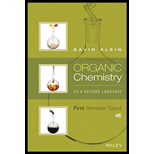
Concept explainers
Interpretation:
The product that is expected for the given reaction has to be drawn.
Concept Introduction:

Hydrogenation reaction is one of the reactions that alkynes undergo. Addition of hydrogen is the hydrogenation reaction. This can be accomplished by using hydrogen molecule and metal catalyst. Hydrogenation reaction is also known as reduction reaction.
When an alkyne undergoes hydrogenation reaction with hydrogen and catalyst such as platinum, the final product obtained will be

Under the above conditions, the alkene cannot be isolated. This is because the alkene is more reactive than the alkyne towards hydrogenation.
If the alkene has to be obtained from alkyne means, then a partially deactivated catalyst like Lindlar’s catalyst or sodium in liquid ammonia can be used. Partially deactivated catalyst is known as poisoned catalyst. When the alkyne is reduced using Lindlar’s catalyst, the alkene product obtained will be having cis configuration. If the alkyne is reduced using sodium in liquid ammonia means the alkene obtained will be having trans configuration.

Want to see the full answer?
Check out a sample textbook solution
Chapter 12 Solutions
Organic Chemistry As a Second Language: First Semester Topics
 ChemistryChemistryISBN:9781305957404Author:Steven S. Zumdahl, Susan A. Zumdahl, Donald J. DeCostePublisher:Cengage Learning
ChemistryChemistryISBN:9781305957404Author:Steven S. Zumdahl, Susan A. Zumdahl, Donald J. DeCostePublisher:Cengage Learning ChemistryChemistryISBN:9781259911156Author:Raymond Chang Dr., Jason Overby ProfessorPublisher:McGraw-Hill Education
ChemistryChemistryISBN:9781259911156Author:Raymond Chang Dr., Jason Overby ProfessorPublisher:McGraw-Hill Education Principles of Instrumental AnalysisChemistryISBN:9781305577213Author:Douglas A. Skoog, F. James Holler, Stanley R. CrouchPublisher:Cengage Learning
Principles of Instrumental AnalysisChemistryISBN:9781305577213Author:Douglas A. Skoog, F. James Holler, Stanley R. CrouchPublisher:Cengage Learning Organic ChemistryChemistryISBN:9780078021558Author:Janice Gorzynski Smith Dr.Publisher:McGraw-Hill Education
Organic ChemistryChemistryISBN:9780078021558Author:Janice Gorzynski Smith Dr.Publisher:McGraw-Hill Education Chemistry: Principles and ReactionsChemistryISBN:9781305079373Author:William L. Masterton, Cecile N. HurleyPublisher:Cengage Learning
Chemistry: Principles and ReactionsChemistryISBN:9781305079373Author:William L. Masterton, Cecile N. HurleyPublisher:Cengage Learning Elementary Principles of Chemical Processes, Bind...ChemistryISBN:9781118431221Author:Richard M. Felder, Ronald W. Rousseau, Lisa G. BullardPublisher:WILEY
Elementary Principles of Chemical Processes, Bind...ChemistryISBN:9781118431221Author:Richard M. Felder, Ronald W. Rousseau, Lisa G. BullardPublisher:WILEY





